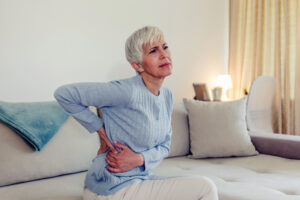Decompression with Interlaminar Stabilization
Spinal stenosis is a condition that affects the space inside your spine, where your nerves are. The space gets progressively smaller and puts pressure on your nerves, causing symptoms to get worse over time.
If symptoms don’t improve with non-surgical options but your spine isn’t stable enough for minimally invasive surgery, you may be a candidate for a surgery called decompression with interlaminar stabilization.
During the surgery, one of our surgeons will make a small incision in your lower back. They shave away parts of the back of your spine bone as well as thickened parts of the facet joint and ligaments. While this opens the space in your spine and takes the pressure off the nerves, it can leave some patients’ spines in need of additional support.
At this point, the surgeon will place a small stabilization device called a coflex into the decompressed area. This stabilizes your spine and keeps the decompressed area open without fusing your spine, allowing you to maintain your range of motion.
The key with any spinal stenosis treatment is to identify the level of treatment you need. Our neurological team can complete a comprehensive exam and determine the best course of treatment for you.
Indication
The coflex device is not for everyone. The coflex Interlaminar Technology is an interlaminar stabilization device indicated for use in one or two-level lumbar stenosis from L1-L5 in skeletally mature patients with at least moderate impairment in function, who experience relief in flexion from their symptoms of leg/buttocks/groin pain, with or without back pain, and who have undergone at least 6 months of non-operative treatment. The coflex is intended to be implanted midline between the adjacent lamina of 1 or 2 contiguous lumbar motion segments. Interlaminar stabilization is performed after decompression of stenosis at the affected level(s).
Procedure
The goal of spinal stenosis surgery is to take away bone or neural elements that are impinging on the nerves that are trying to extend to the rest of your body. After the surgeon performs a direct decompression that removes bone, facet, ligament and/or disc segments from the narrowed spinal canal, your spine can become unstable. The coflex device is then inserted directly following a decompression procedure to help keep your spine stable while maintaining normal height and motion in your spine.
The unique design of the coflex device maintains stability in the spine after direct surgical decompression while preserving more natural movement in the treated area.
Post-Operative Instructions
There is no fusion, and therefore no healing bone to wait for, so you’ll most likely be able to walk right after your procedure. You’ll notice that your pain has been significantly relieved, and your spine should feel stable and strong. Most patients do need to wait several days following the surgery for the incision wound to heal.
Weeks and Months Following Surgery
In the weeks and months following surgery, your recovery depends on a number of factors, including the degree of your stenosis and the extent of the decompression that was performed. Most patients are able to return to normal activity and even expanded activities such as golf, cycling, gardening and other activities, within weeks of the surgery. Some patients may require physical therapy to help with mobility and flexibility.
Every patient is different; therefore results may vary.
Cost
The cost of decompression with interlaminar stabilization is based on several considerations. This can include both the extent of the procedure and a patient’s insurance carrier. Medicare can cover this procedure if it is deemed necessary treatment. BEST accepts Medicare, most private health insurances, and works with workers’ compensation claims and personal injury cases at all of our centers.
Reach out to BEST Health System Today
To learn more about decompression with interlaminar stabilization and if it is right for you, contact BEST Health System today. Our caring and experienced team of treatment professionals can help you develop a personalized treatment plan that is right for you. We are dedicated to getting you the quality of life you deserve.
Procedure Doctors
Related Articles
Finding Relief from Complex Regional Pain Syndrome
Most Common Symptoms of Complex Regional Pain Syndrome Complex regional pain syndrome, sometimes referred to as CRPS, is a chronic condition that causes patients to […]
How To Know If I Have Neuropathy
Understanding Neuropathy Neuropathy, also known as nerve damage, is a common condition that affects a range of patients. When nerves are damaged, they cannot successfully […]
Understanding Phantom Limb Pain
What is Phantom Limb Pain? Phantom limb pain is a complex condition that affects patients who suffered a traumatic injury that resulted in them having […]
Four Reasons Why Complex Regional Pain Syndrome Develops
Understanding Complex Regional Pain Syndrome Complex regional pain syndrome, CRPS, is a common condition that affects a variety of patients. Patients with CRPS may experience […]
Natural Remedies for Neuropathy Treatment
Understanding Common Neuropathy Symptoms Neuropathy manifests various symptoms – from tingling and numbness sensations to muscle weakness and balance difficulty. It is important for patients […]
Tips for Managing Complex Regional Pain Syndrome
Understanding Complex Regional Pain Syndrome (CRPS) Complex regional pain syndrome (CRPS) is a nerve-related condition that causes patients to experience debilitating pain in a singular […]
Why Some Cancer Patients Develop Neuropathy
Understanding Neuropathy Neuropathy, also known as nerve damage, is a common condition that affects the peripheral nervous system. Patients with this condition often experience debilitating […]
Understanding What Causes Failed Back Surgery Syndrome?
Understanding Failed Back Surgery Syndrome Failed back surgery syndrome can occur for several reasons. In some instances, there’s one, easy-to-identify issue, while in others, there’s […]
Diabetic Neuropathy Treatment Options
Living with Diabetic Neuropathy Painful diabetic neuropathy is a common condition that many diabetes patients suffer from. Neuropathy, commonly referred to as nerve damage, can […]
FAQs about Phantom Limb Pain
Understanding Phantom Limb Pain Phantom limb pain is a chronic condition that affects patients who have recently had an amputation. Patients with this condition often […]
Spinal Cord Stimulation Therapy for Failed Back Surgery Syndrome
How Spinal Cord Stimulation Therapy Works Spinal cord stimulation therapy is a common treatment option recommended to patients who suffer from debilitating chronic pain as […]
At-Home Therapies to Minimize Chronic Pain
Understanding the Severity of Chronic Pain Chronic pain is a common condition that affects a large range of patients for various reasons. This type of […]













